
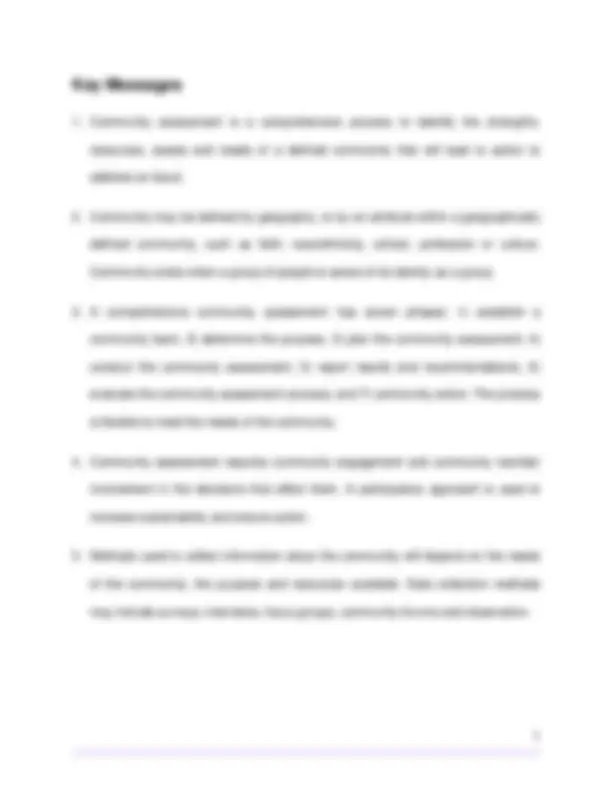
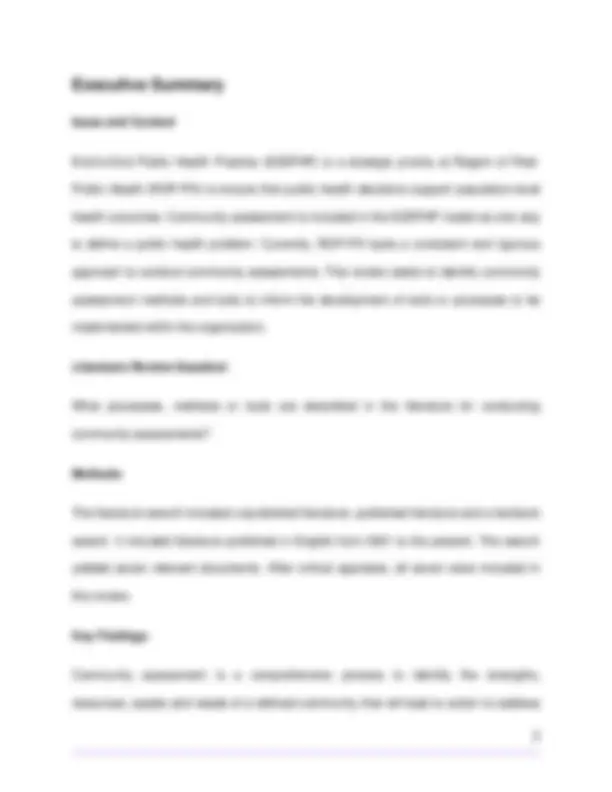
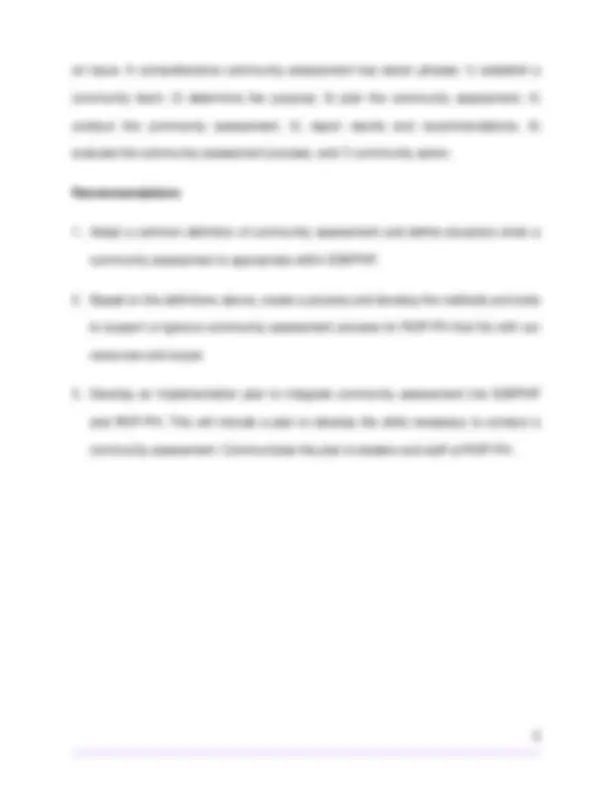
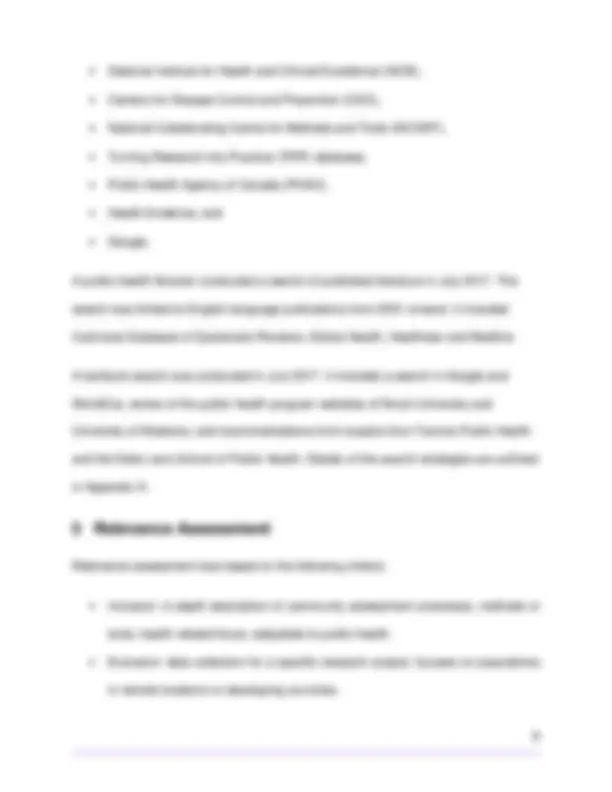
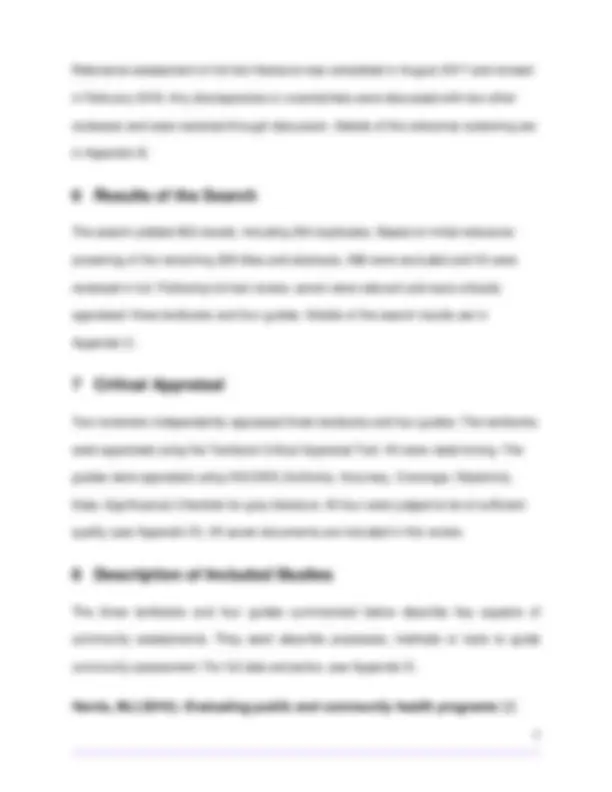
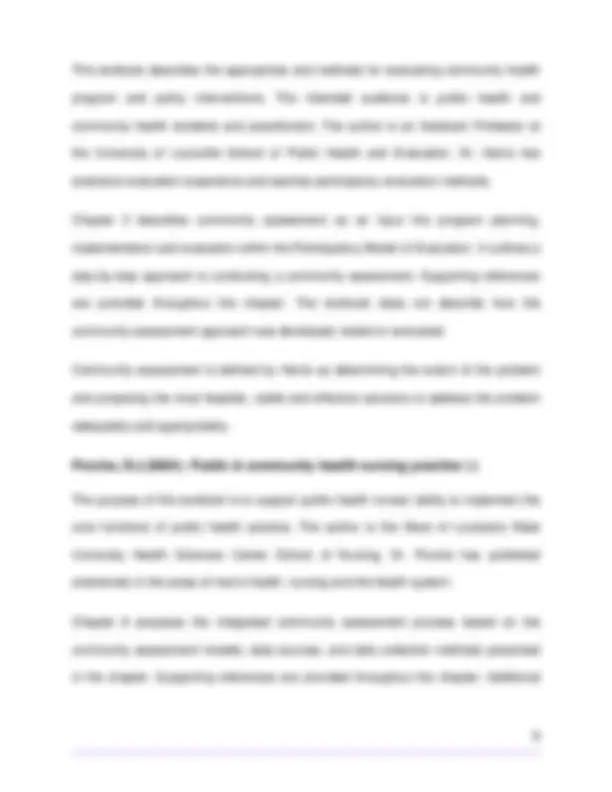
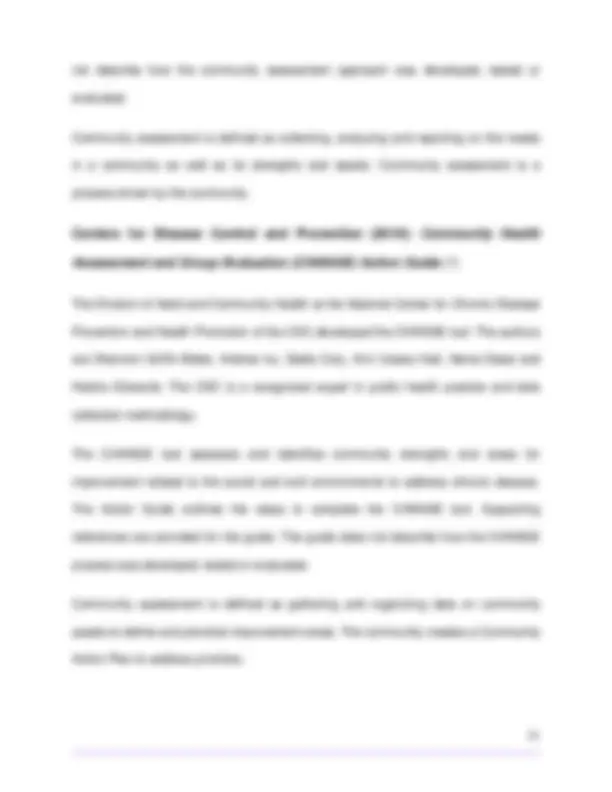
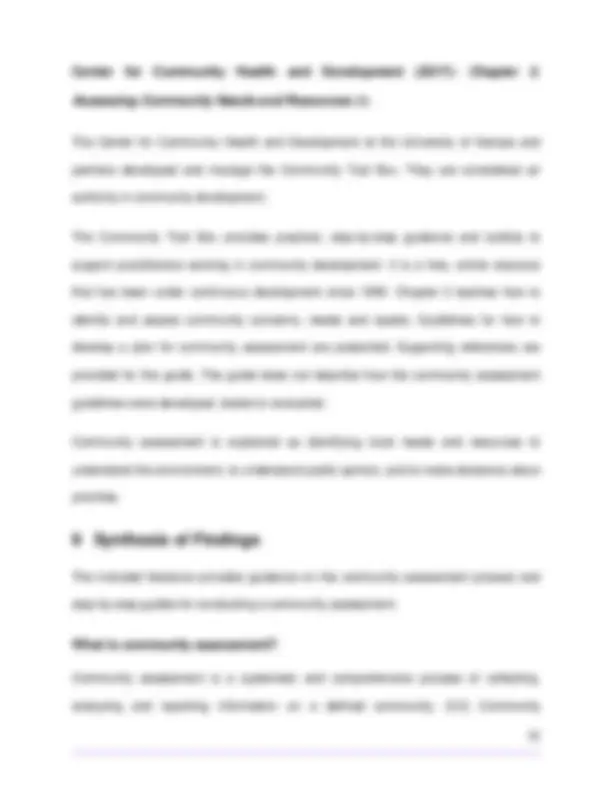
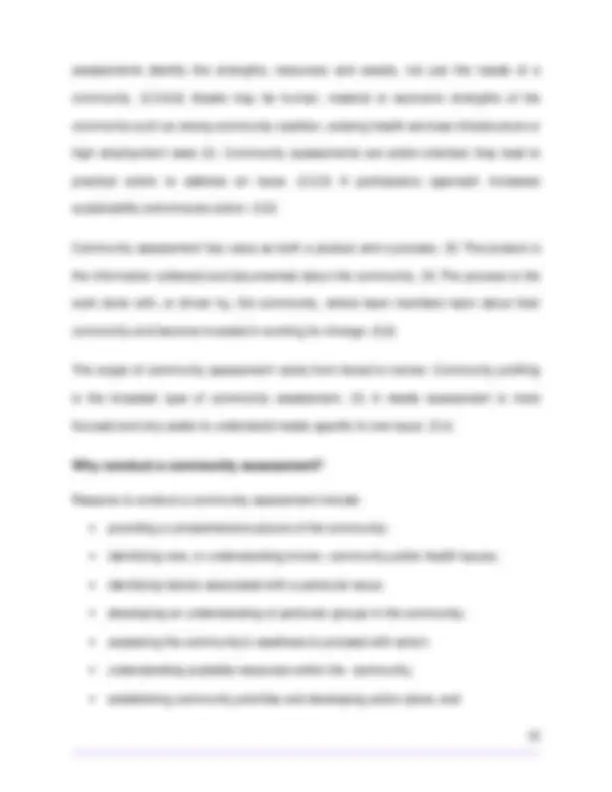
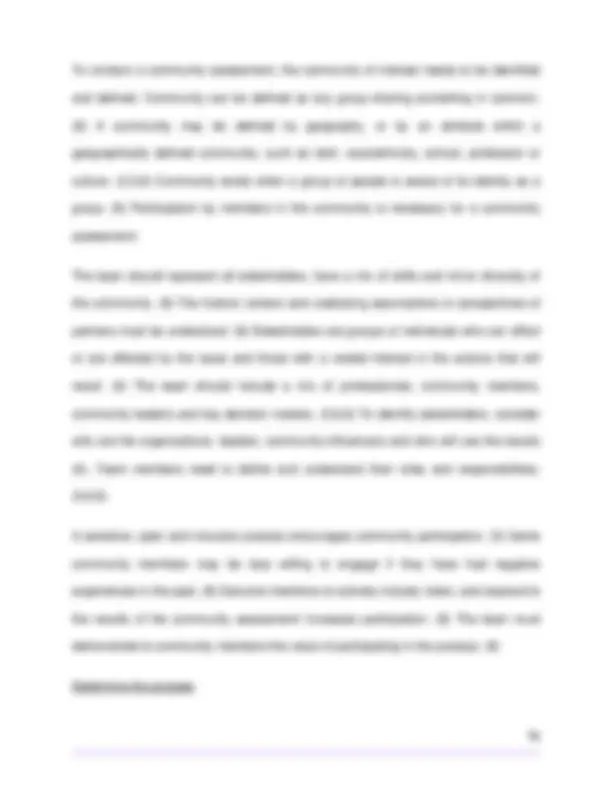
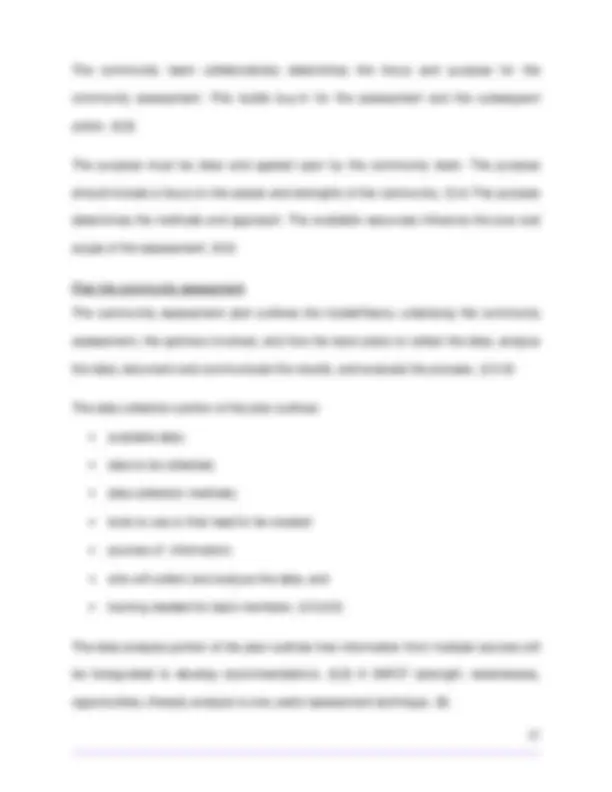
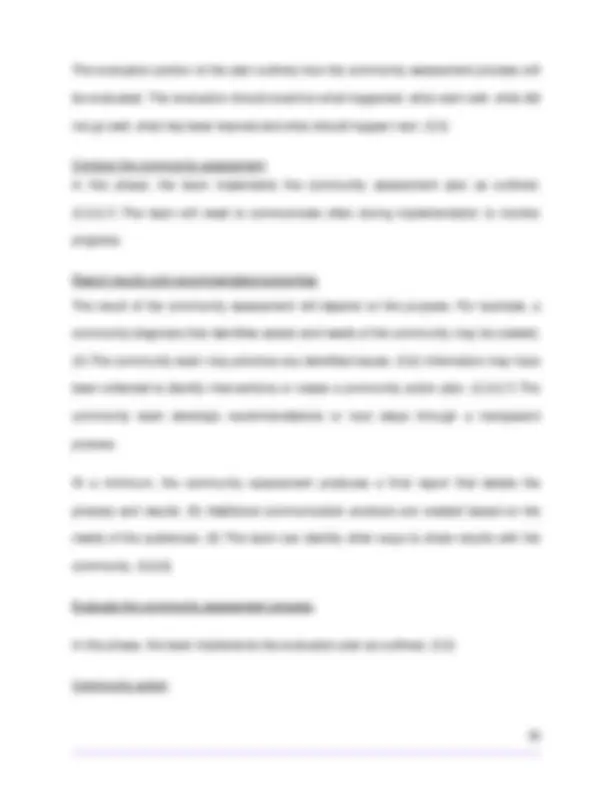
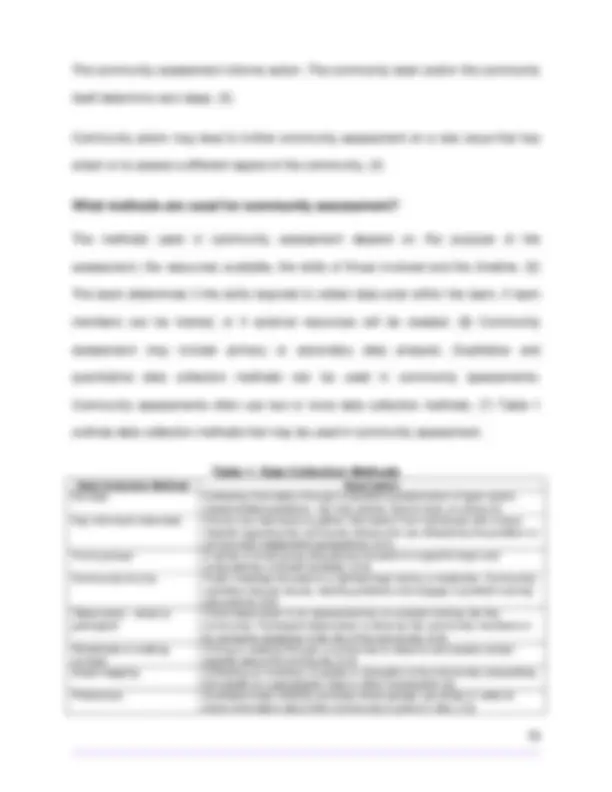
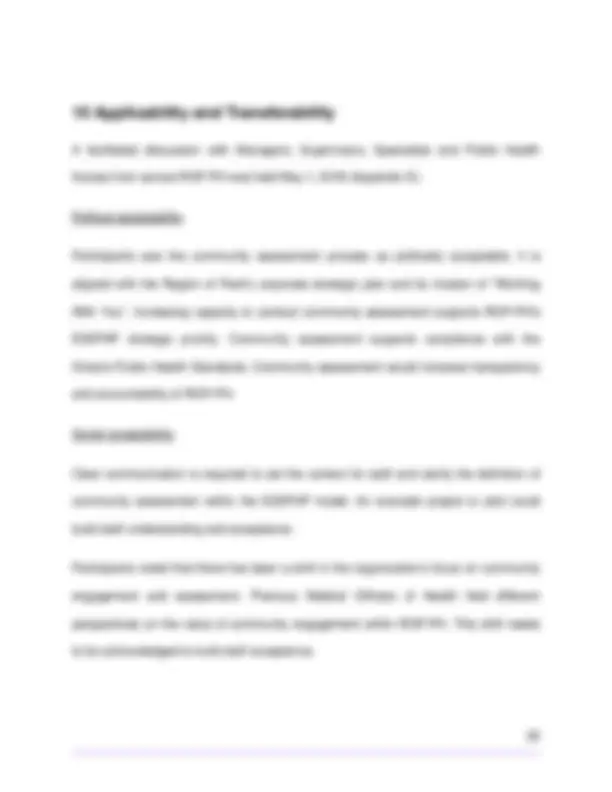
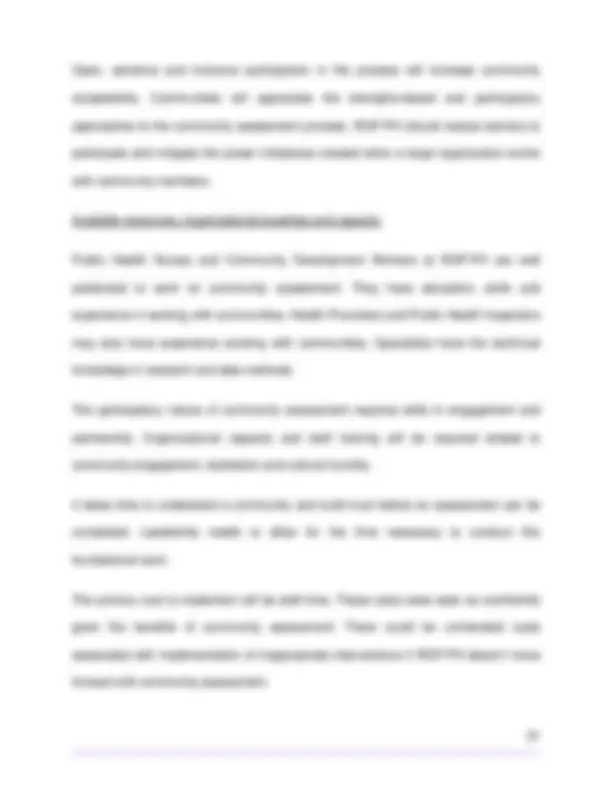
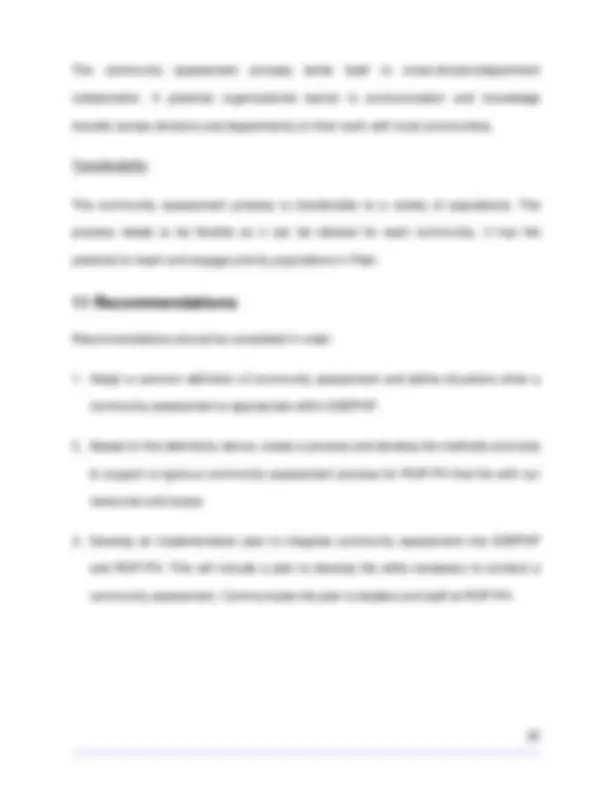
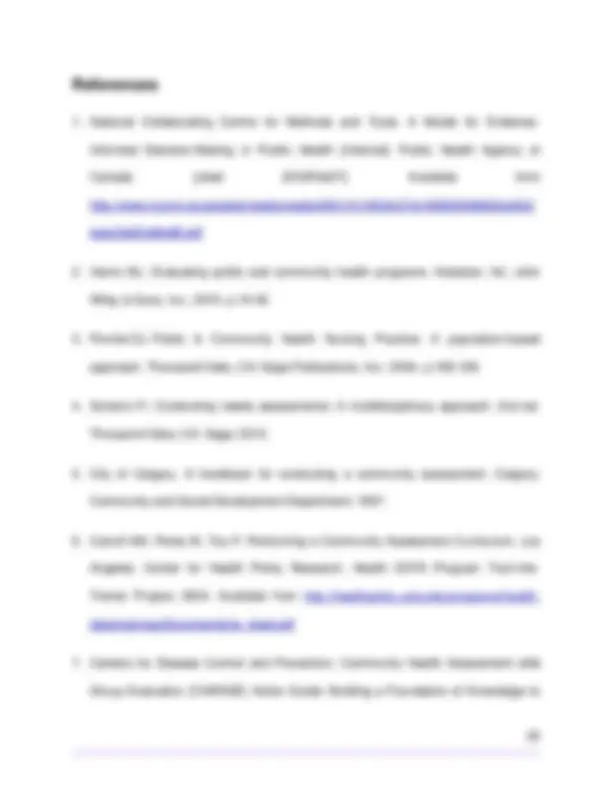
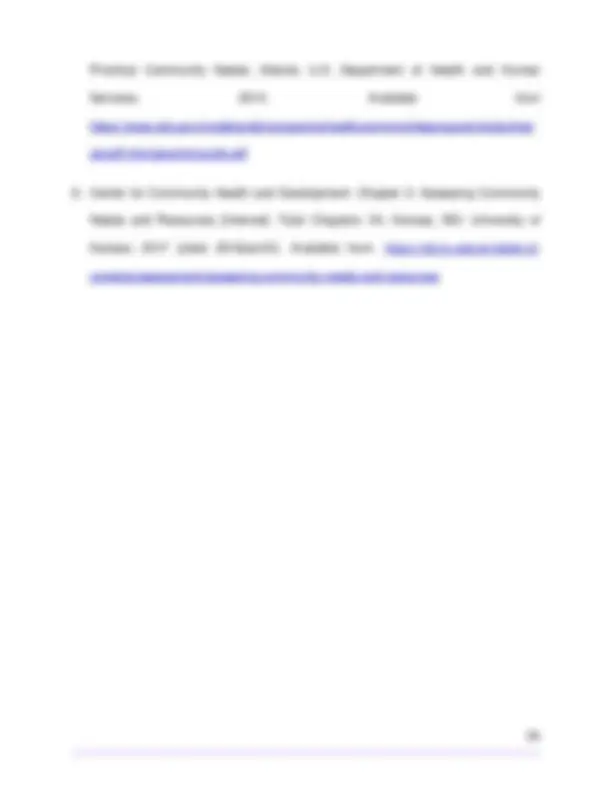
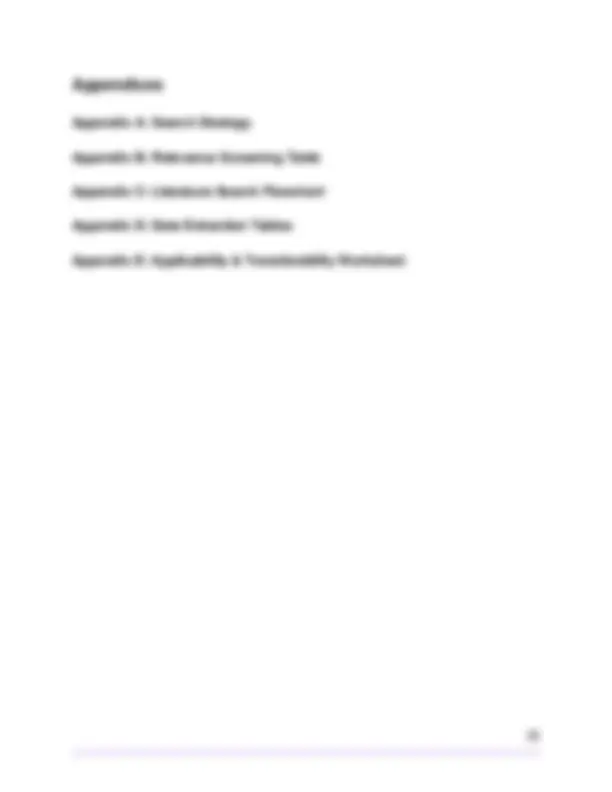
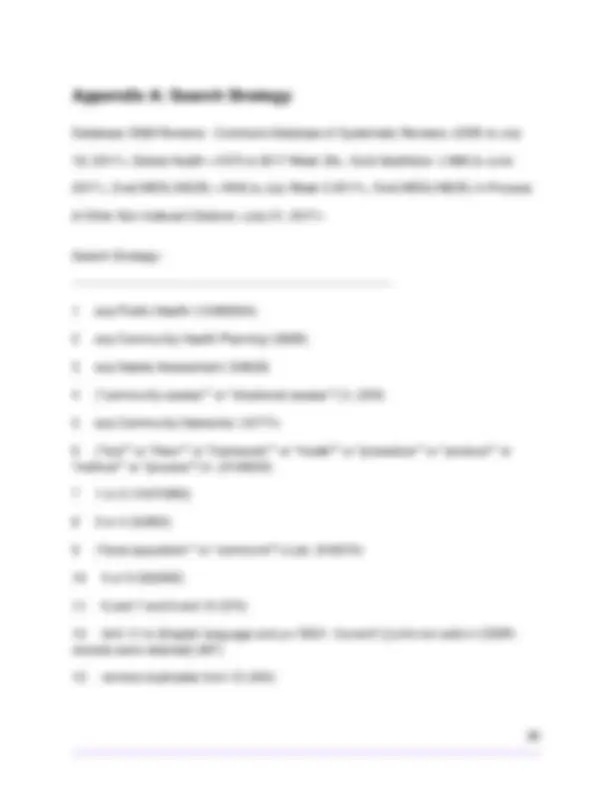
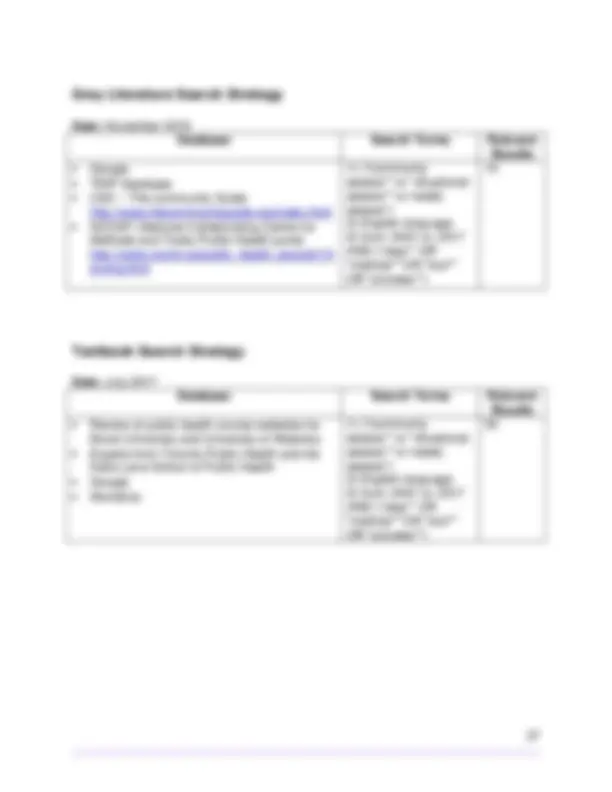
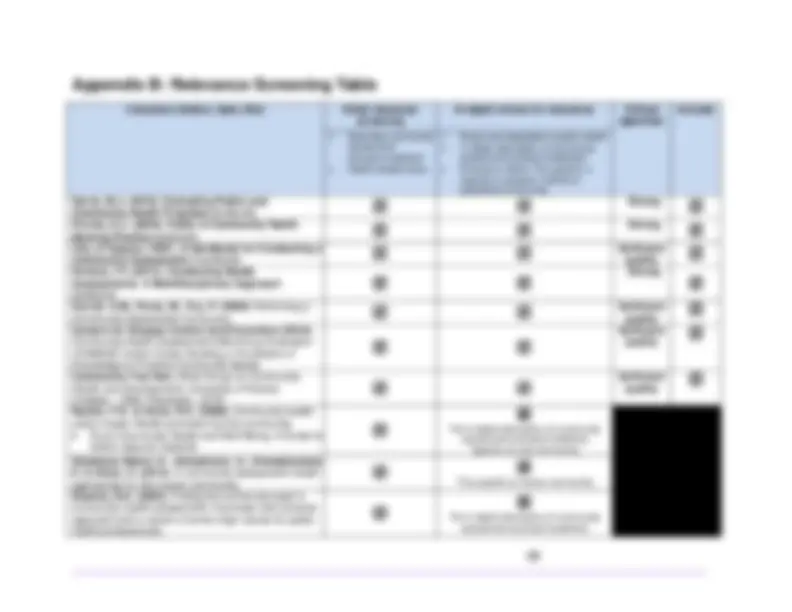
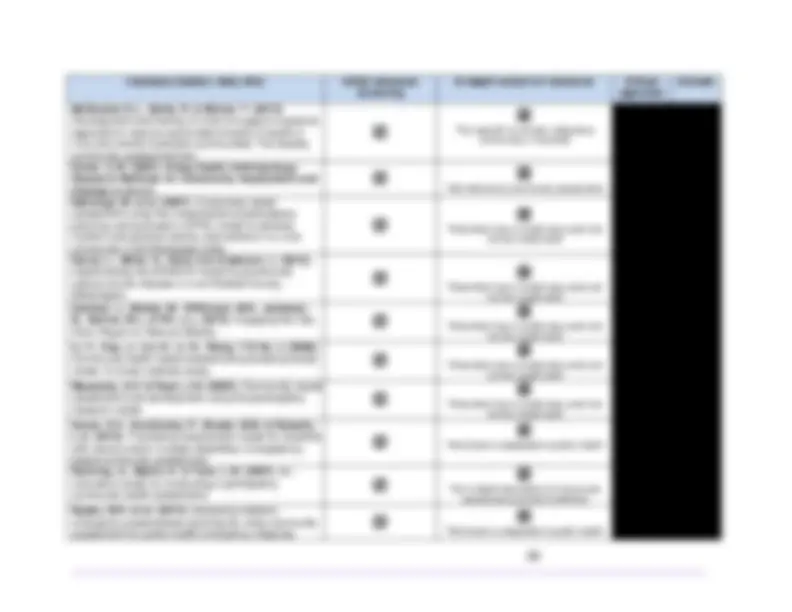
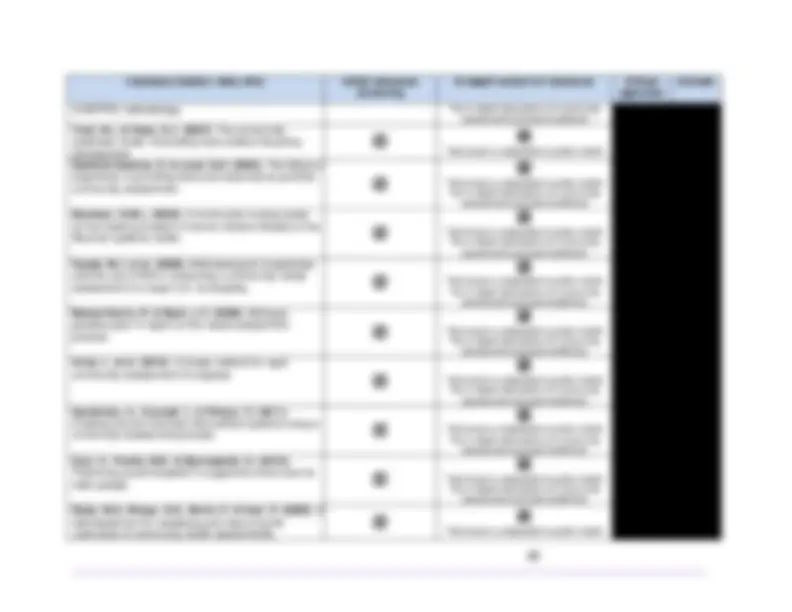
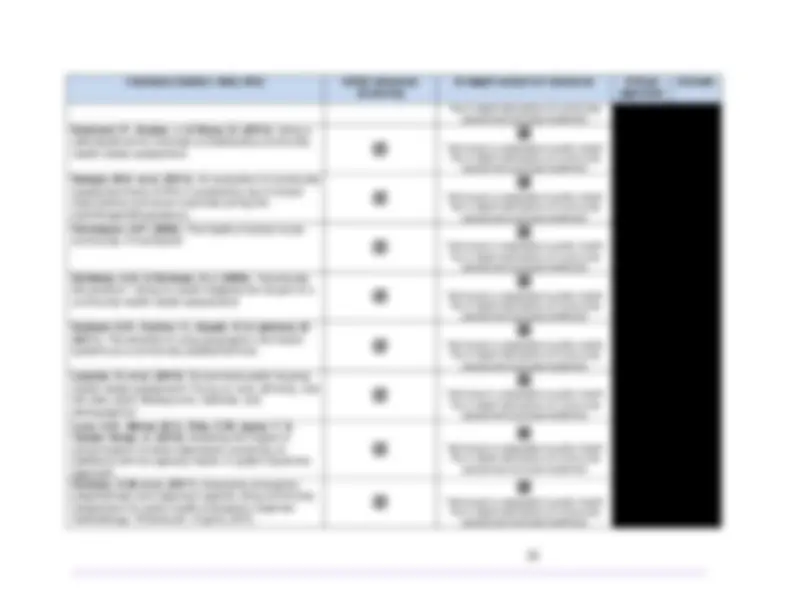
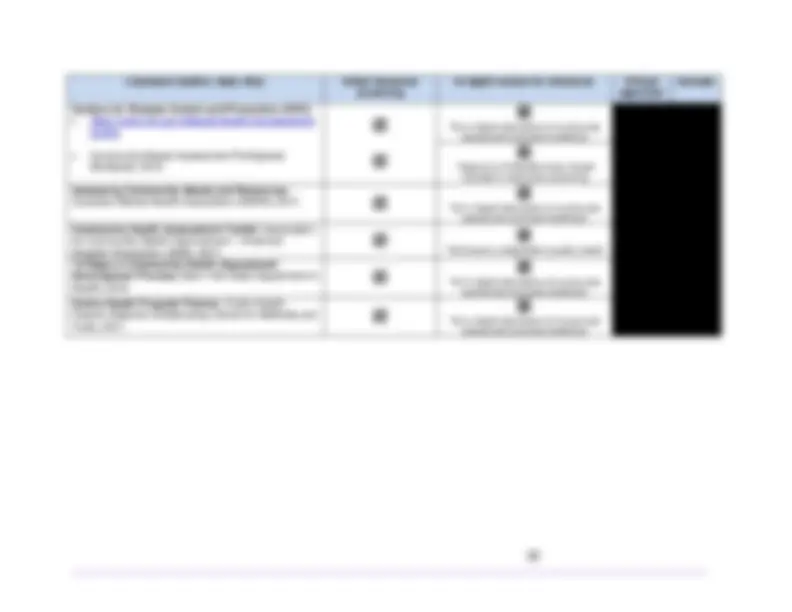
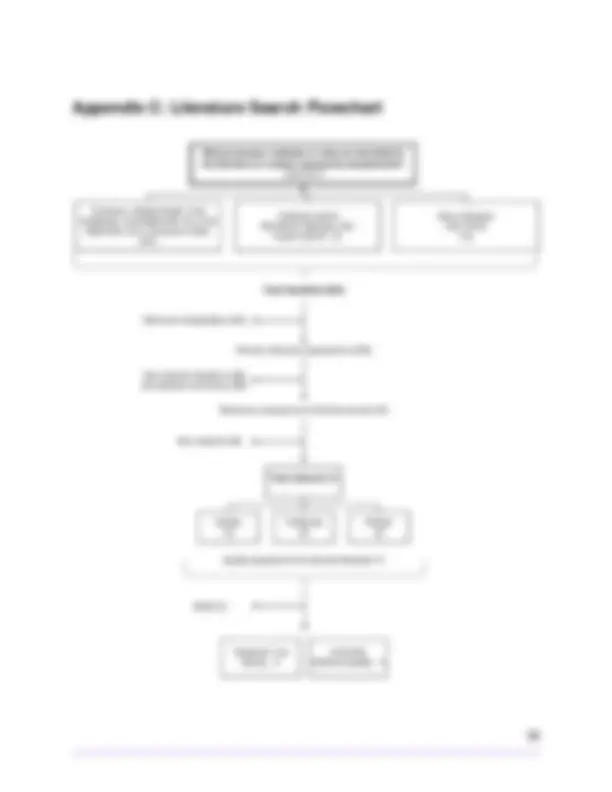
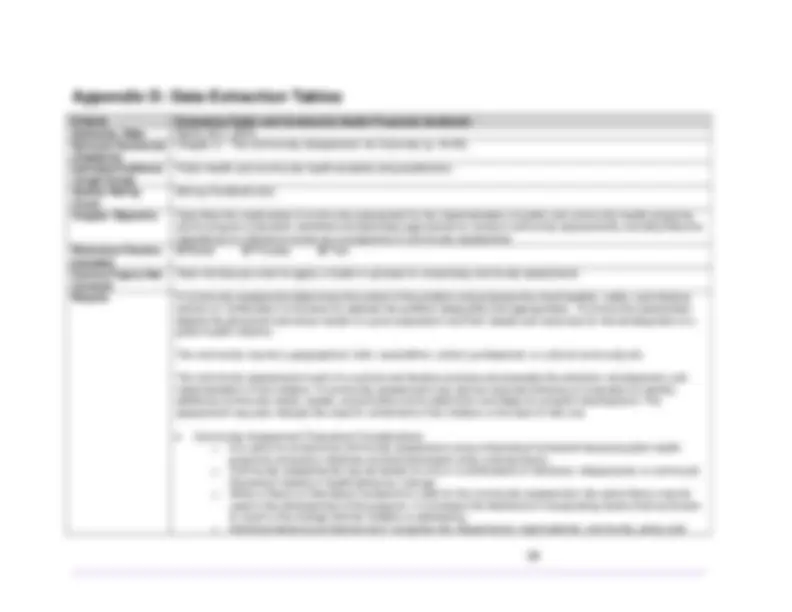
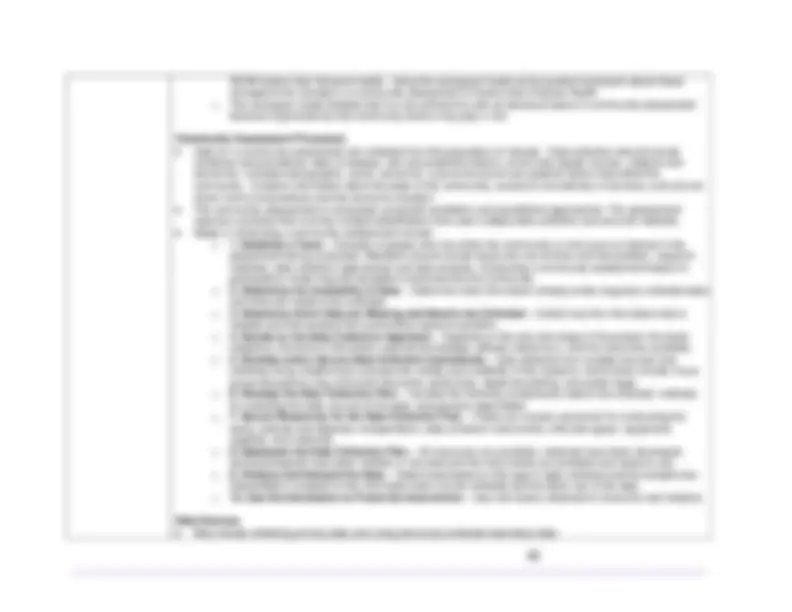
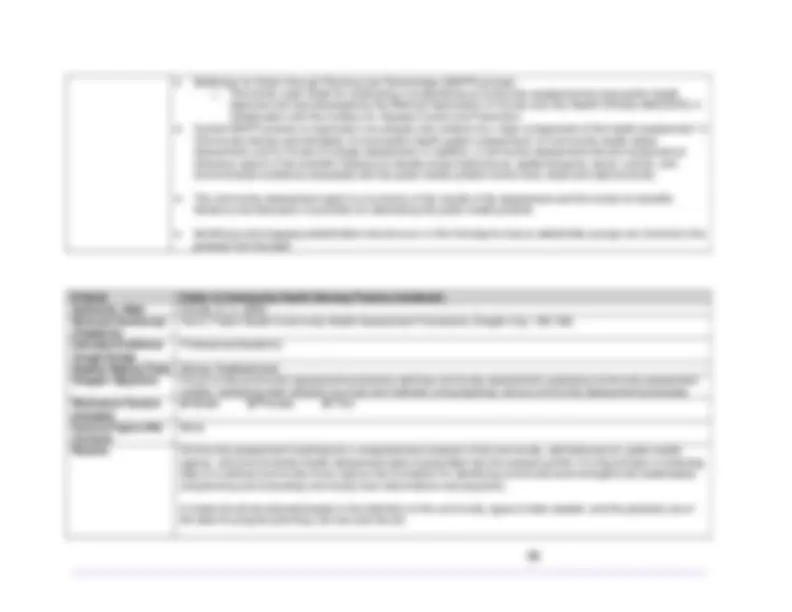
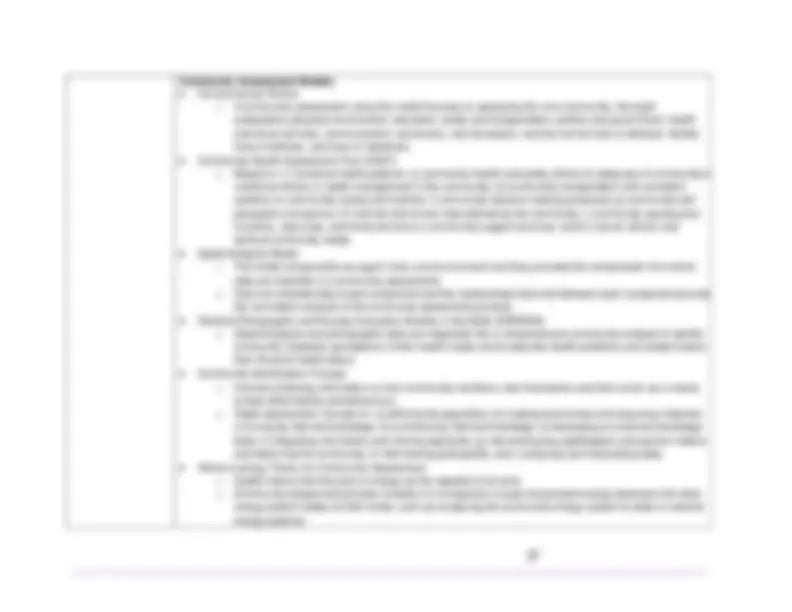
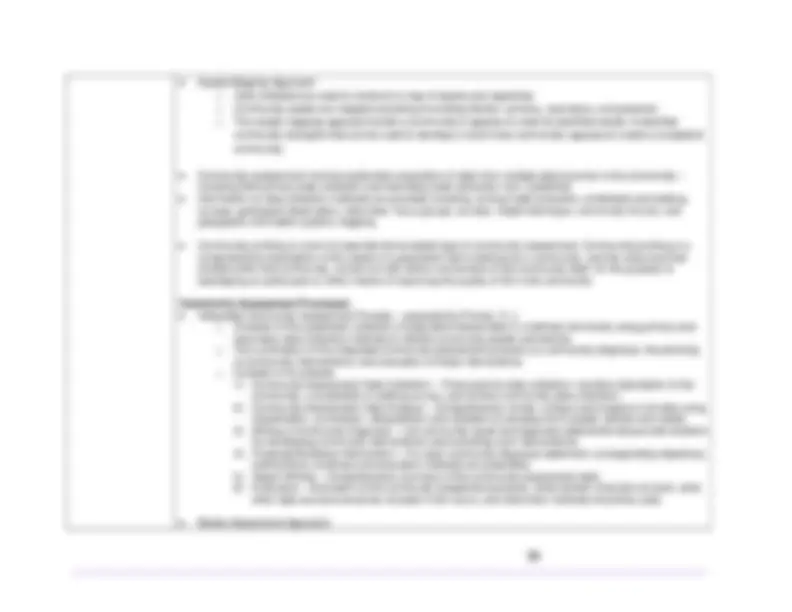
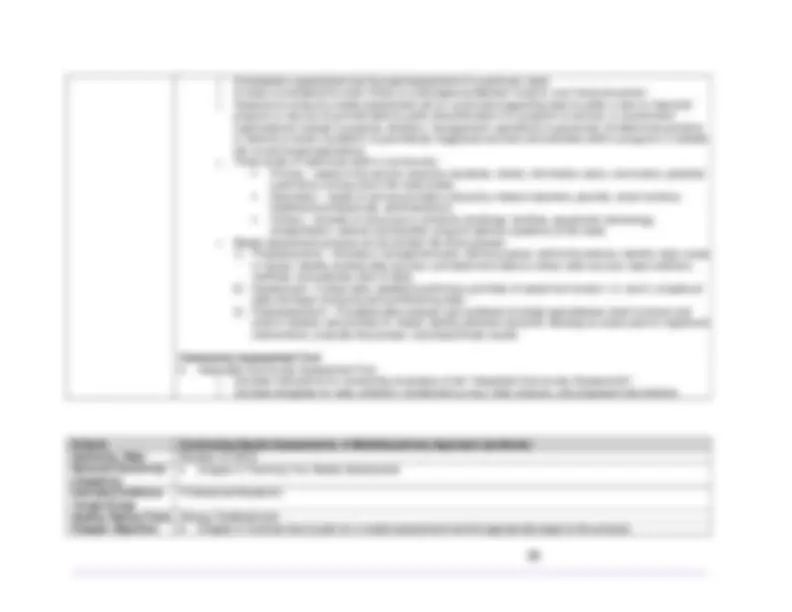
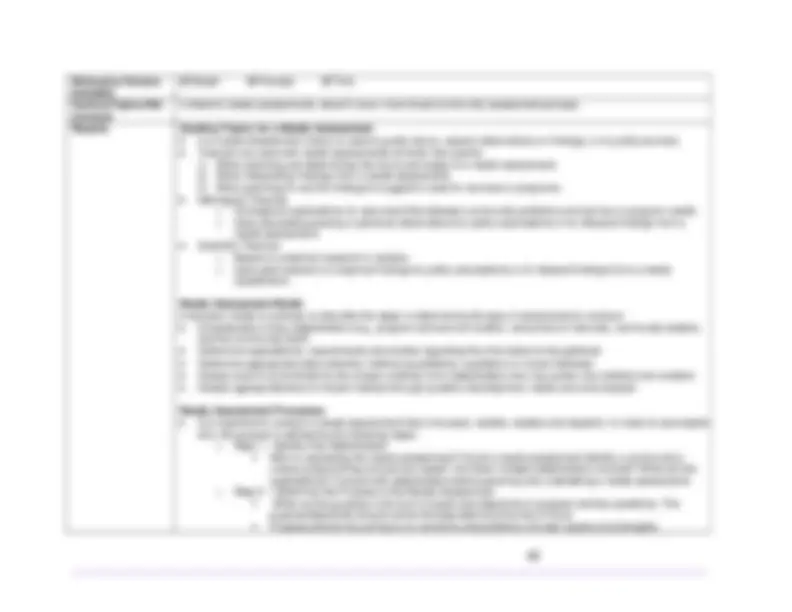
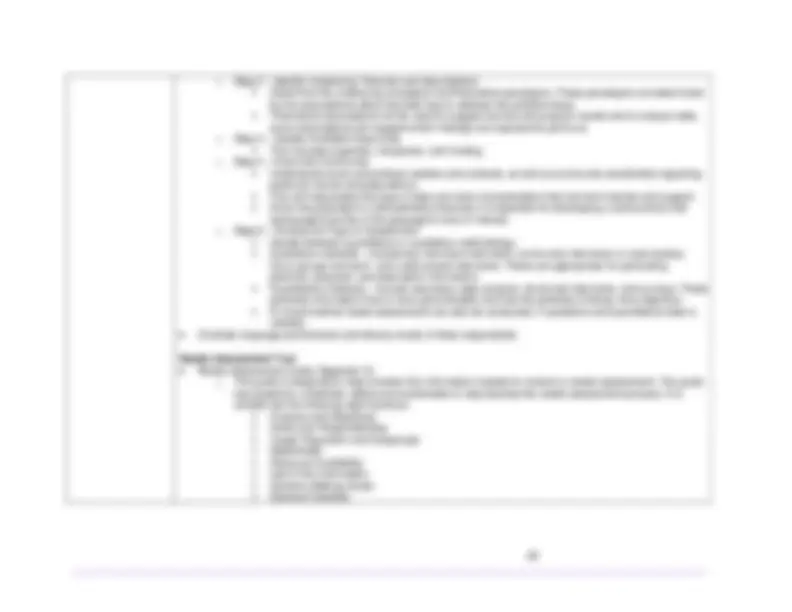
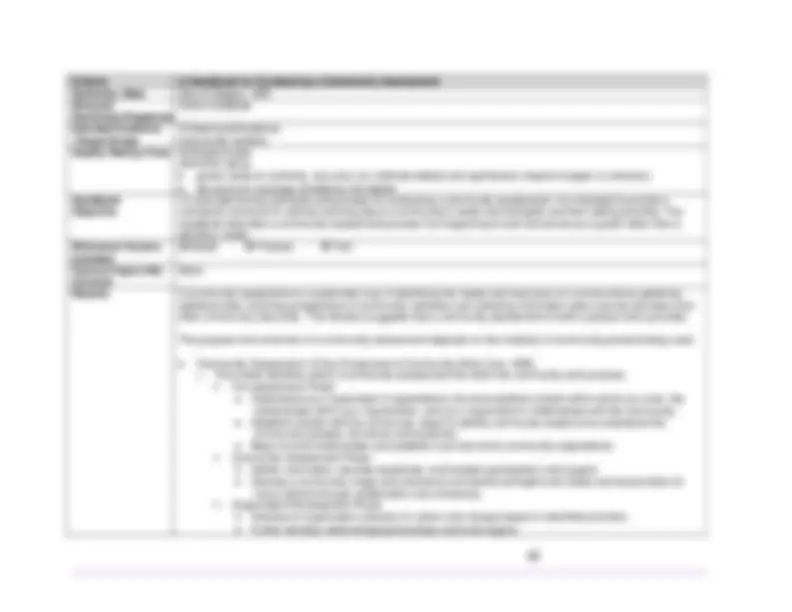

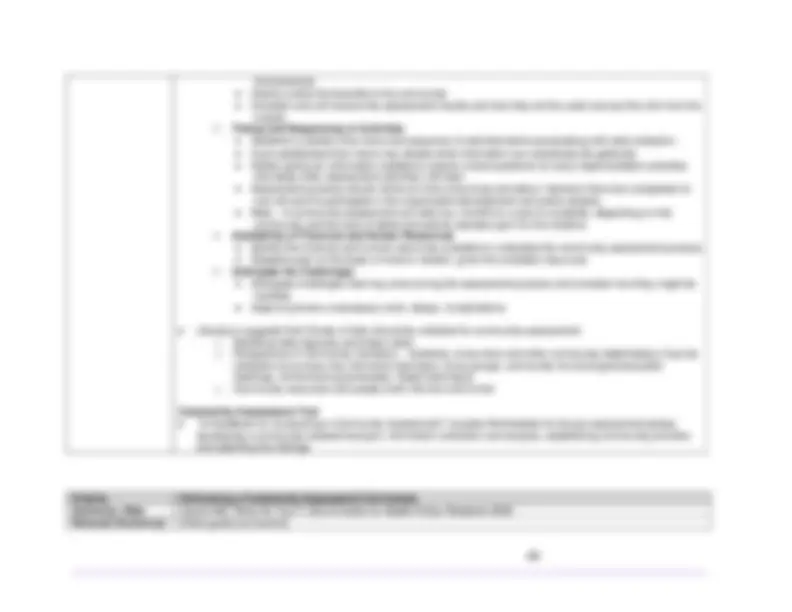
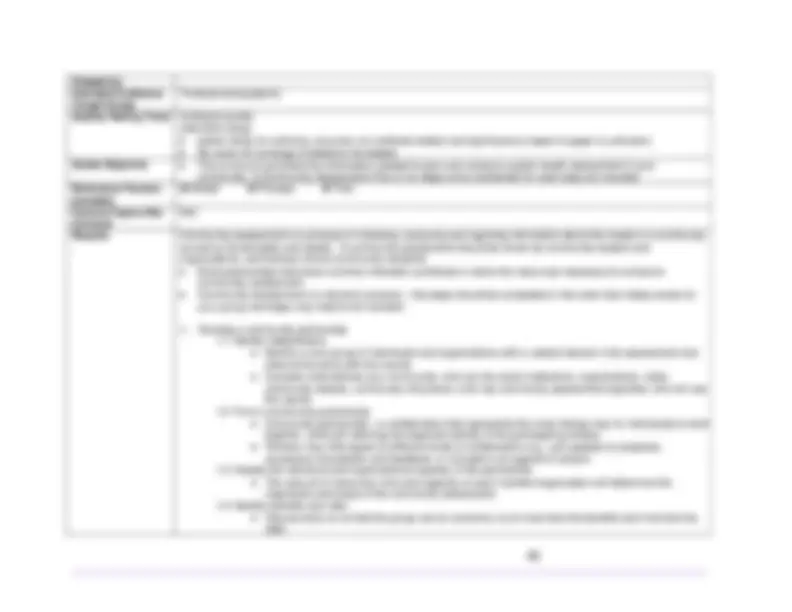
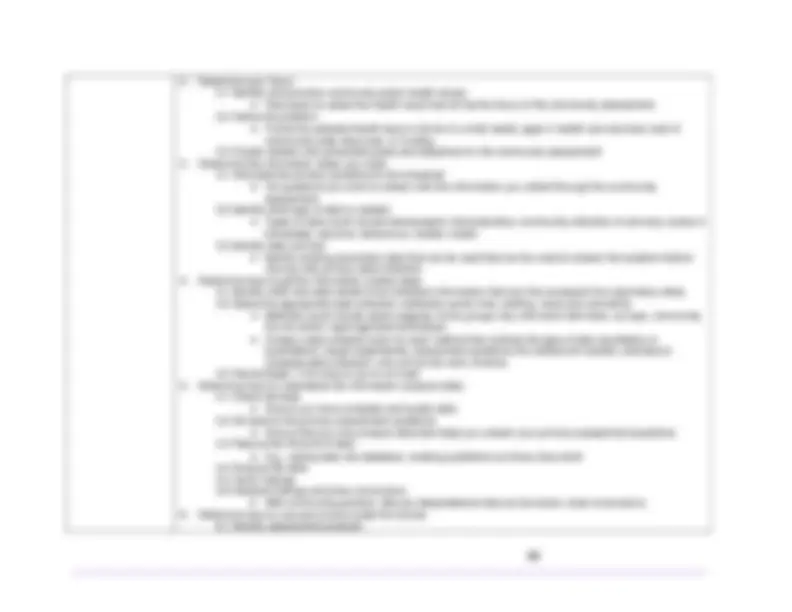
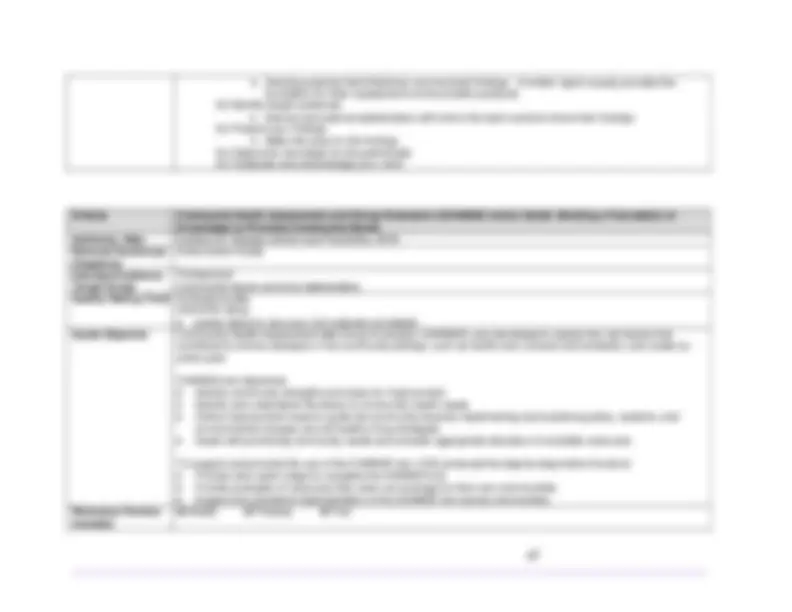
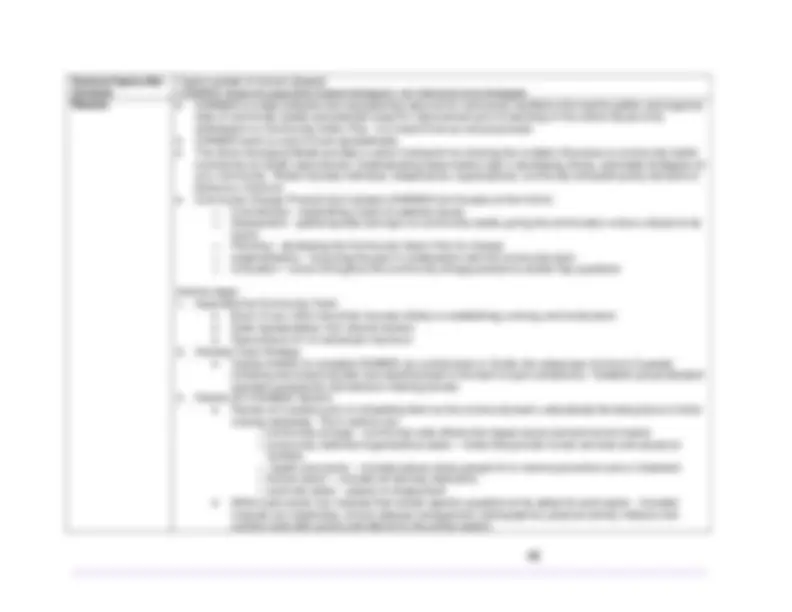
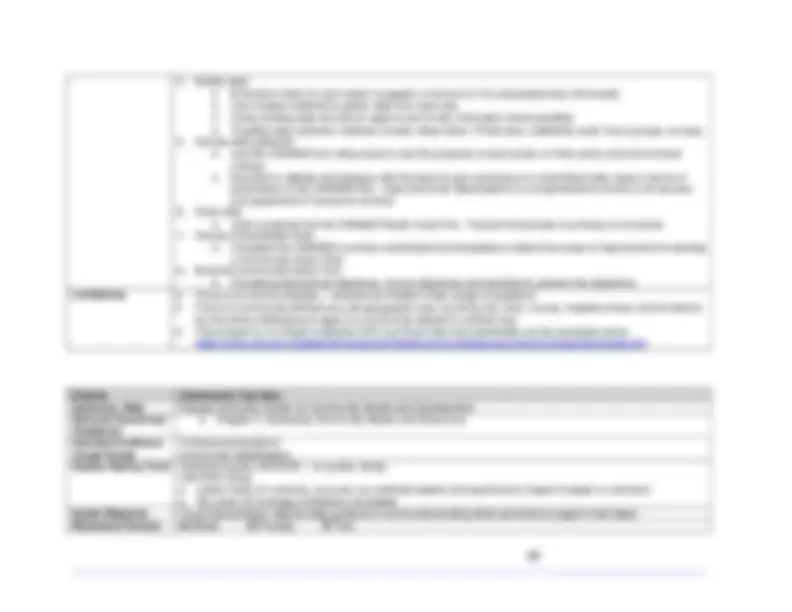
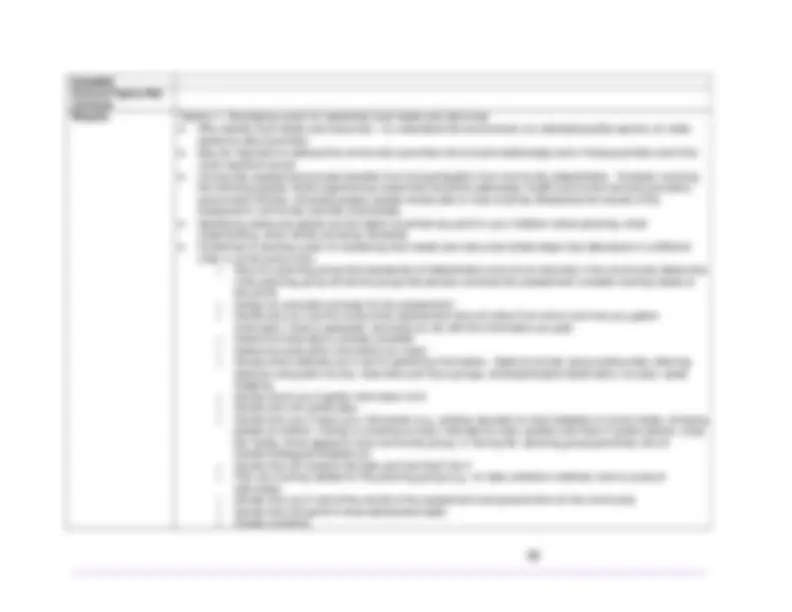
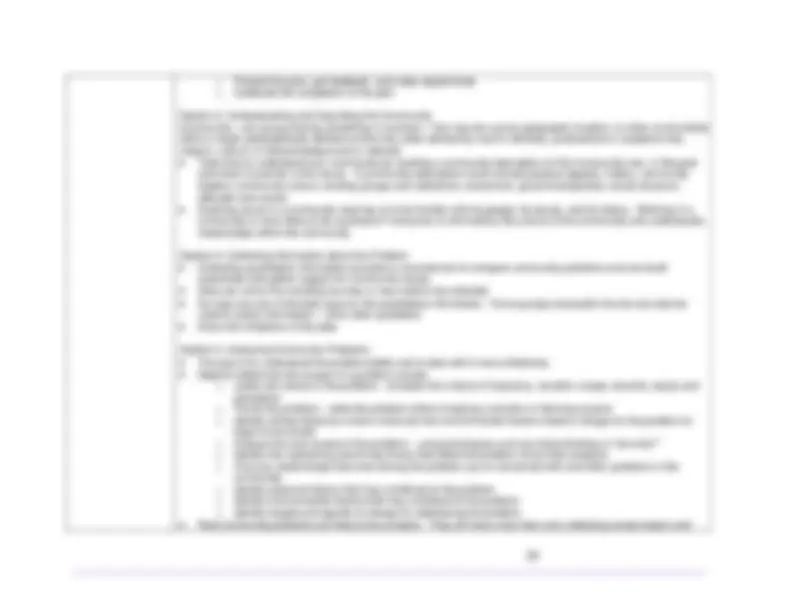

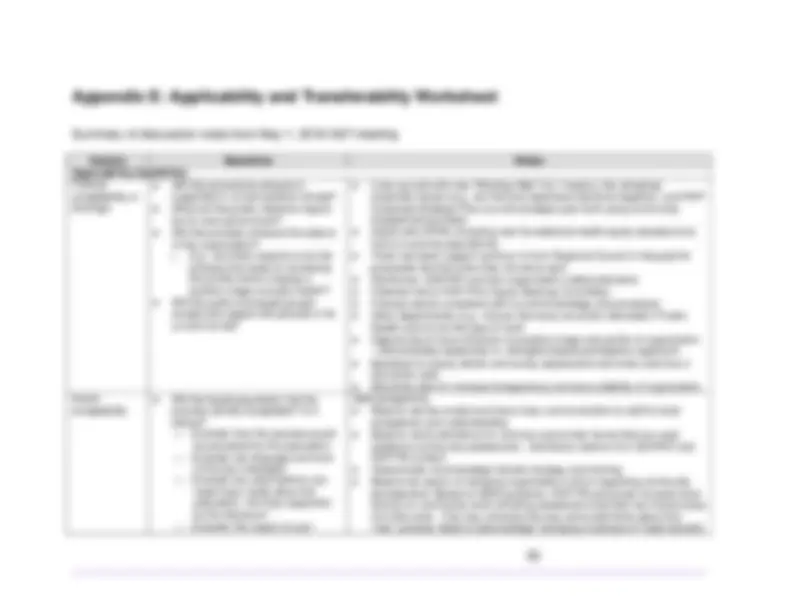
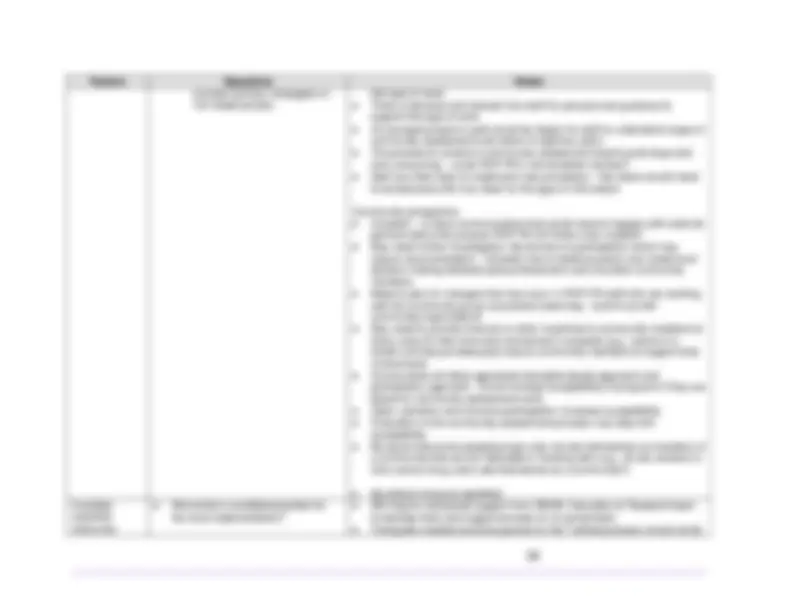
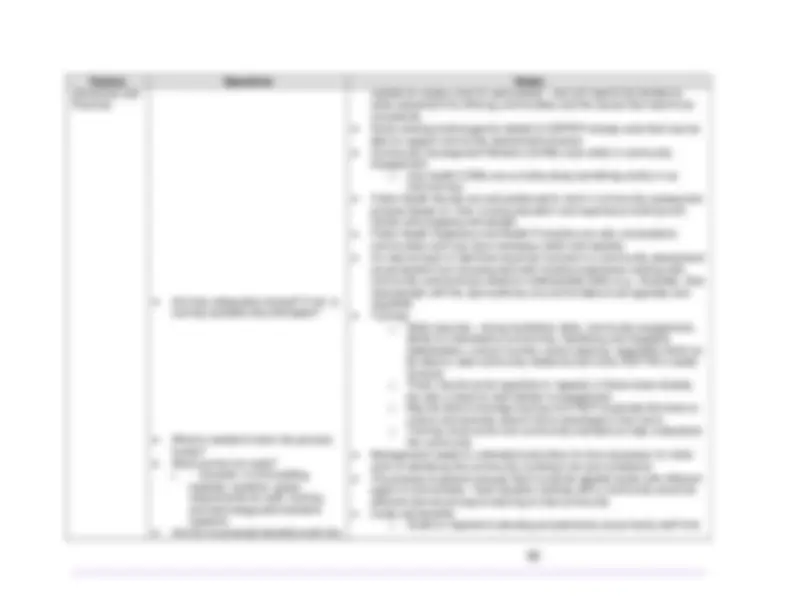
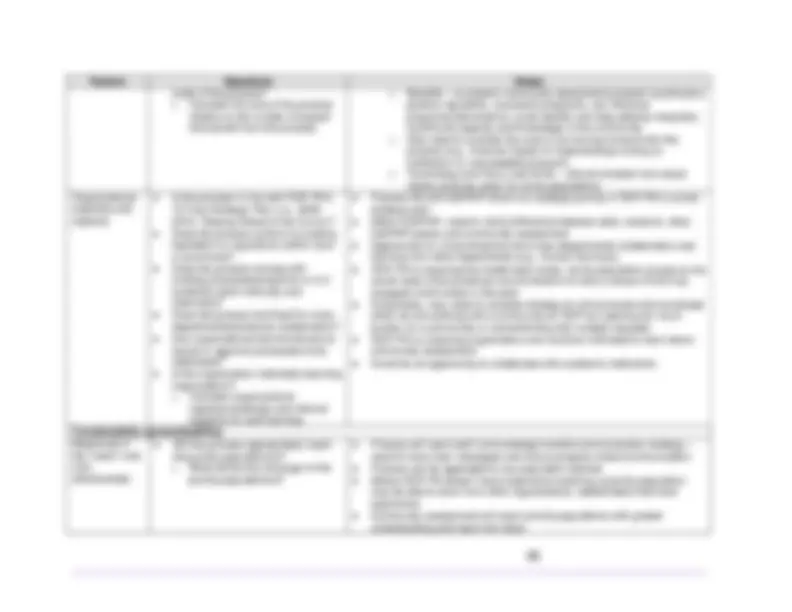
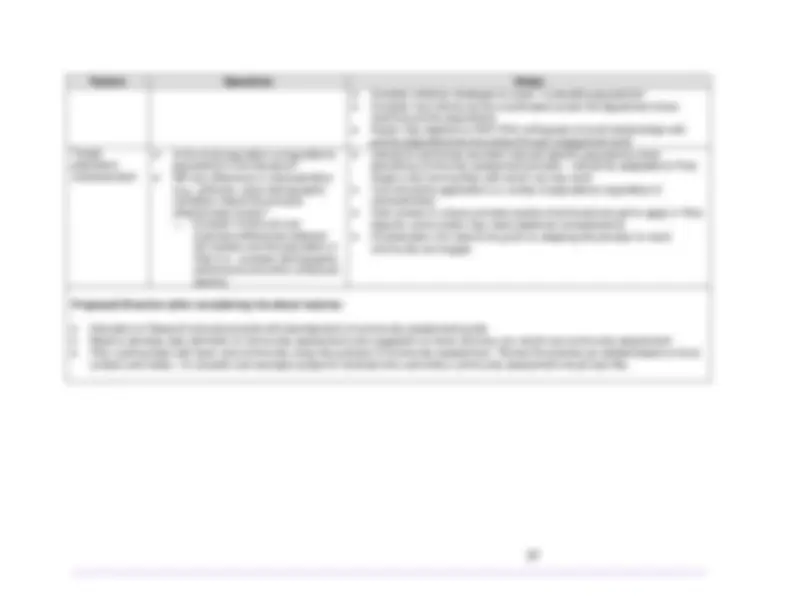


Study with the several resources on Docsity

Earn points by helping other students or get them with a premium plan


Prepare for your exams
Study with the several resources on Docsity

Earn points to download
Earn points by helping other students or get them with a premium plan
Community
Ask the community for help and clear up your study doubts
Discover the best universities in your country according to Docsity users
Free resources
Download our free guides on studying techniques, anxiety management strategies, and thesis advice from Docsity tutors
Dr. Porche has published extensively in the areas of men's health, nursing and the health system. Chapter 8 proposes the integrated community assessment process ...
Typology: Exercises
1 / 59

This page cannot be seen from the preview
Don't miss anything!




















































Julie Richardson, Analyst, Research and Policy Nancy Ramuscak, Program Manager Sondra Davis, Analyst, Research and Policy Teresa Ho, Advisor
July 2018
Issue and Context
End-to-End Public Health Practice (E2EPHP) is a strategic priority at Region of Peel- Public Health (ROP-PH) to ensure that public health decisions support population-level health outcomes. Community assessment is included in the E2EPHP model as one way to define a public health problem. Currently, ROP-PH lacks a consistent and rigorous approach to conduct community assessments. This review seeks to identify community assessment methods and tools to inform the development of tools or processes to be implemented within the organization.
Literature Review Question
What processes, methods or tools are described in the literature for conducting community assessments?
Methods
The literature search included unpublished literature, published literature and a textbook search. It included literature published in English from 2001 to the present. The search yielded seven relevant documents. After critical appraisal, all seven were included in this review.
Key Findings
Community assessment is a comprehensive process to identify the strengths, resources, assets and needs of a defined community that will lead to action to address
an issue. A comprehensive community assessment has seven phases: 1) establish a community team, 2) determine the purpose, 3) plan the community assessment, 4) conduct the community assessment, 5) report results and recommendations, 6) evaluate the community assessment process, and 7) community action.
Recommendations
Community and political preferences and actions; and Best available research findings. (1)
Community assessment is a way to gather information about community health issues, local context, and community preferences and actions.
Community assessment processes can incorporate methods that are similar to existing E2EPHP methods. For example, community assessments can include the use of health status data, primary data or published literature. The use of these types of data is already established in E2EPHP processes. ROP-PH needs to define situations when a community assessment is required within our E2EPHP approach.
ROP-PH supports the development of consistent, robust and well-documented methods for community assessment as one component of E2EPHP. The purpose of this review is to identify methods and tools to inform community assessment processes at ROP- PH.
What processes, methods or tools for conducting community assessments are described in the literature?
A search of unpublished literature was conducted in November 2016. The search was limited to English-language publications, from 2001 onward. It included: National Guideline Clearinghouse, World Health Organization (WHO),
National Institute for Health and Clinical Excellence (NICE), Centers for Disease Control and Prevention (CDC), National Collaborating Centre for Methods and Tools (NCCMT), Turning Research into Practice (TRIP) database, Public Health Agency of Canada (PHAC), Health Evidence, and Google.
A public health librarian conducted a search of published literature in July 2017. The search was limited to English-language publications from 2001 onward. It included Cochrane Database of Systematic Reviews, Global Health, Healthstar and Medline.
A textbook search was conducted in July 2017. It included a search in Google and WorldCat, review of the public health program websites of Brock University and University of Waterloo, and recommendations from experts from Toronto Public Health and the Dalla Lana School of Public Health. Details of the search strategies are outlined in Appendix A.
Relevance assessment was based on the following criteria:
Inclusion: in-depth description of community assessment processes, methods or tools; health-related focus; adaptable to public health. Exclusion: data collection for a specific research project; focuses on populations in remote locations or developing countries.
This textbook describes the approaches and methods for evaluating community health program and policy interventions. The intended audience is public health and community health students and practitioners. The author is an Assistant Professor at the University of Louisville School of Public Health and Evaluation. Dr. Harris has extensive evaluation experience and teaches participatory evaluation methods.
Chapter 2 describes community assessment as an input into program planning, implementation and evaluation within the Participatory Model of Evaluation. It outlines a step-by-step approach to conducting a community assessment. Supporting references are provided throughout the chapter. The textbook does not describe how the community assessment approach was developed, tested or evaluated.
Community assessment is defined by Harris as determining the extent of the problem and proposing the most feasible, viable and effective solutions to address the problem adequately and appropriately.
The purpose of this textbook is to support public health nurses’ ability to implement the core functions of public health practice. The author is the Dean of Louisiana State University Health Sciences Center School of Nursing. Dr. Porche has published extensively in the areas of men’s health, nursing and the health system.
Chapter 8 proposes the integrated community assessment process based on the community assessment models, data sources, and data collection methods presented in the chapter. Supporting references are provided throughout the chapter. Additional
description on how the community assessment approach was developed, tested or evaluated is not provided.
Community assessment is defined by Porche as a comprehensive analysis of a specific community. It is the process of collecting data to identify community-level strengths and weaknesses. With this information, community-level interventions are planned and evaluated.
This textbook provides an understanding of needs assessment methodologies. The intended audience is agencies, programs and researchers conducting needs assessments. The author is a Professor of Human Development at California State University-San Marcos. Dr. Soriano has published in the areas of violence, ethnicity and youth.
Chapter 4 describes the needs assessment process. It outlines steps to develop a plan and how to collect and analyze the data. Supporting references are provided for the chapter. The textbook does not describe how the needs assessment process was developed, tested or evaluated.
A definition of community assessment was not provided.
not describe how the community assessment approach was developed, tested or evaluated.
Community assessment is defined as collecting, analyzing and reporting on the needs in a community as well as its strengths and assets. Community assessment is a process driven by the community.
The Division of Adult and Community Health at the National Center for Chronic Disease Prevention and Health Promotion of the CDC developed the CHANGE tool. The authors are Shannon Griffin-Blake, Andrae Ivy, Stella Cory, Ann Ussery-Hall, Hema Desai and Keisha Edwards. The CDC is a recognized expert in public health practice and data collection methodology.
The CHANGE tool assesses and identifies community strengths and areas for improvement related to the social and built environments to address chronic disease. The Action Guide outlines the steps to complete the CHANGE tool. Supporting references are provided for the guide. The guide does not describe how the CHANGE process was developed, tested or evaluated.
Community assessment is defined as gathering and organizing data on community assets to define and prioritize improvement areas. The community creates a Community Action Plan to address priorities.
The Center for Community Health and Development at the University of Kansas and partners developed and manage the Community Tool Box. They are considered an authority in community development.
The Community Tool Box provides practical, step-by-step guidance and toolkits to support practitioners working in community development. It is a free, online resource that has been under continuous development since 1994. Chapter 3 teaches how to identify and assess community concerns, needs and assets. Guidelines for how to develop a plan for community assessment are presented. Supporting references are provided for the guide. The guide does not describe how the community assessment guidelines were developed, tested or evaluated.
Community assessment is explained as identifying local needs and resources to understand the environment, to understand public opinion, and to make decisions about priorities.
The included literature provides guidance on the community assessment process and step-by-step guides for conducting a community assessment.
Community assessment is a systematic and comprehensive process of collecting, analyzing and reporting information on a defined community. (3,5) Community
gathering data to develop an intervention, including baseline data. (2,5,6)
One or more theories or models can be selected to guide the community assessment and outline underlying assumptions. (2) Models are useful to focus the purpose, to aid in interpreting the findings or to develop programs/initiatives based on the findings. (2-4) No single model for community assessment emerged. The model should be selected based on the fit to the community, the types of data needed and how the data will be used for planning. (3) The community may already be using a model for community development that can be applied to the community assessment. (5)
Community assessment looks at more than the individual factors that influence health. (2,7) The selected model should provide a framework to assess interpersonal, organizational, community and public policy factors that play a role in health. (2,7)
A comprehensive community assessment process has seven phases: 1) establish a community team, 2) determine the purpose, 3) plan the community assessment, 4) conduct the community assessment, 5) report results and recommendations, 6) evaluate the community assessment process, and 7) community action. Community assessment is a dynamic, iterative process. (2,6) The process adapts to meet the needs, ideas and timelines available.
Figure 1. Community Assessment Process
Establish a community team Community assessment is conducted through partnership. These partnerships are built thoughtfully to achieve the established purpose. The aim of this phase is to develop community partnerships and establish a team. (2,5-8) Community assessment requires community engagement and community member involvement in the decisions that affect them. Before starting a community assessment, an understanding of the people, structures and dynamics of the community is required. (5) Identifying and engaging stakeholders and community members early on in the process builds relationships and establishes trust. (2,5-8) In some cases, relationships and a community group will already exist.
The community team collaboratively determines the focus and purpose for the community assessment. This builds buy-in for the assessment and the subsequent action. (6,8)
The purpose must be clear and agreed upon by the community team. The purpose should include a focus on the assets and strengths of the community. (3,4) The purpose determines the methods and approach. The available resources influence the size and scope of the assessment. (6,8)
Plan the community assessment The community assessment plan outlines the model/theory underlying the community assessment, the partners involved, and how the team plans to collect the data, analyze the data, document and communicate the results, and evaluate the process. (2,5-8)
The data collection portion of the plan outlines: available data; data to be collected; data collection methods; tools to use or that need to be created sources of information; who will collect and analyze the data; and training needed for team members. (2,5,6,8)
The data analysis portion of the plan outlines how information from multiple sources will be triangulated to develop recommendations. (6,8) A SWOT (strength, weaknesses, opportunities, threats) analysis is one useful assessment technique. (8)
The evaluation portion of the plan outlines how the community assessment process will be evaluated. The evaluation should examine what happened, what went well, what did not go well, what has been learned and what should happen next. (3,5)
Conduct the community assessment In this phase, the team implements the community assessment plan as outlined. (2,3,5,7) The team will need to communicate often during implementation to monitor progress.
Report results and recommendations/priorities The result of the community assessment will depend on the purpose. For example, a community diagnosis that identifies assets and needs of the community may be created. (3) The community team may prioritize any identified issues. (5,6) Information may have been collected to identify interventions or create a community action plan. (2,3,5,7) The community team develops recommendations or next steps through a transparent process.
At a minimum, the community assessment produces a final report that details the process and results. (6) Additional communication products are created based on the needs of the audiences. (6) The team can identify other ways to share results with the community. (5,6,8)
Evaluate the community assessment process
In this phase, the team implements the evaluation plan as outlined. (3,5)
Community action